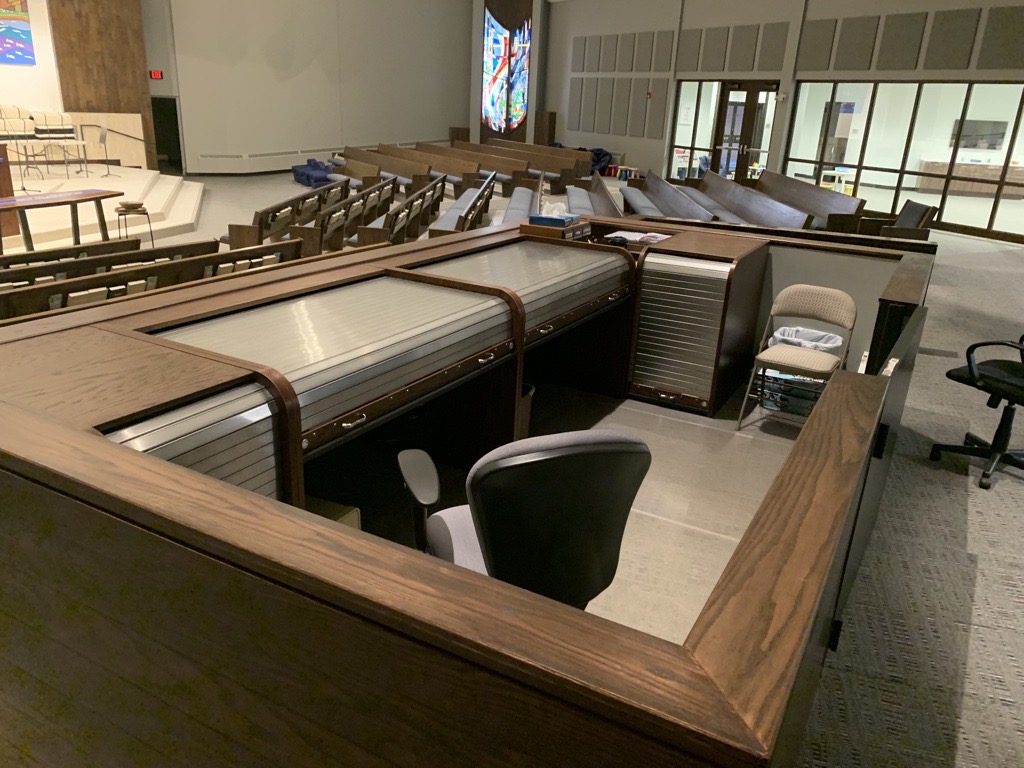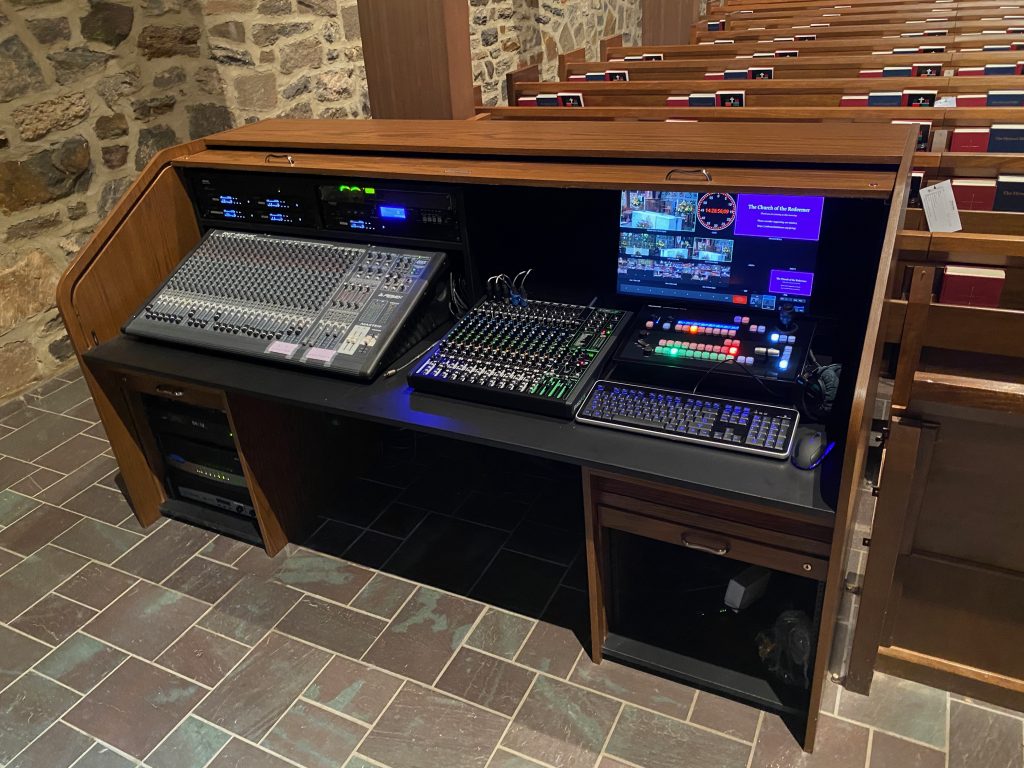
By Tim Adams
I have seen a number of approaches when it comes to securing the audiovisual booth and equipment and while I would guess that most churches don’t struggle with unauthorized access to this space, there are also churches that battle mightily with keeping people out.
First, let’s be frank and admit that while we want to provide a warm, welcoming atmosphere, there are areas in our buildings that we need to limit access to the general public. One of these areas is the AV booth.
Restrict Access
We have come a long way in church building design over the last three decades and while we are certainly seeing a trend that is finally putting the AV booth where it should be (main floor, center, midway back to rear placement), there are countless AV techs who have to deal with booths in the balcony, or worse, behind a window in a small alcove above the sanctuary.
Regardless of where your booth is, restricting access to only those who need it is an important step in safeguarding the investment in important equipment and personnel.
This becomes an increasingly difficult challenge when booths are out in the open on the main floor. However, there are some clever ways I have come across over the years that could be of use to your church or might spark some ideas on how to better secure your booth.
Securing Your Booth
Perhaps you think this topic is moot for your church, and it might be. However, if the last few years should have taught us anything, it’s that when we get complacent about our safety and security, such as with the mindset, “It will never happen to me,” that is when you’re truly in trouble. We are called to be vigilant in our defense against the devil and his schemes and I believe this extends to physical security, as well.
The traditional way in churches to secure their equipment is with a wooden rolltop desk setup, where a set of wooden slats moves within two tracks on either side of the desk to roll over the top of the equipment and secure it with a lock. This system has worked and continues to work for many churches. However, a simple set of tools could render this measure useless in a couple of minutes.
The step up from this would be to make the slats and track material metal. This has a very nice, clean look and beefs up the physical security, but with time and an angle grinder, this, too, can be defeated fairly easily.
Layered Security
The truth is any system can ultimately be defeated. The trick is to utilize “layered” security as much as possible. The military term is “defense in depth.” You start with what you want to protect and work out from there. The most obvious way to protect your booth is to put a locking door on it. Even if you have a booth out in the open of your sanctuary, putting a door on it imparts a message of “authorized users only.” Most of the time, people will respect this boundary. However, there are those in our congregations that have no compunction about sharing their opinions on how we are doing during the service.
With these individuals, I have found it helpful to utilize “standards” that you can point to. For example, when you have opinions about how loud or quiet your audio mix is, you can point to an inexpensive decibel meter and share with the person that you are at or below the approved dB level. One church I worked at had a hard limit of 95dB, regardless of what was happening on stage. This allowed us to point to that meter and let them know, with visual reference, that we were providing appropriate sound levels. However, if the feedback you’re getting is constructive or provides insight into how people are experiencing the service negatively, this needs to be taken under advisement.
Locking Doors
Next, we move out from the booth to the sanctuary itself. Often, the sanctuary doors do not even have locks; however, if you can work with leadership to change that, this provides another layer of security from potential thieves.
The final layer should be the building’s physical security itself; that means locked doors as often as possible to control access to the building (even at the risk of inconveniencing members and staff) and an active alarm system.
In some circumstances, you may have to explore further steps. We are working on a new church project that is not in a good part of town and prior to our even bringing equipment into the church, they had experienced break-ins. So we have taken the following steps to try and protect our client’s investment:
- Stage rack is physically connected to the wall via hinges and a locking articulating gate lock and padlock. The rack is on wheels and can “swing away” from the wall to work in the back of the rack, but when it’s secured, it’s physically locked to the wall.
- All equipment in all racks (stage, booth upper, booth lower) is secured with security rack screws, meaning you have to have the correct bit to loosen the screws holding in the equipment. The bits are widely available; however, a thief is not likely to be prepared for that and anything we can do to interrupt their ease of stealing equipment is a good thing.
- The booth upper and booth lower racks are physically screwed together to make it more difficult to “walk off” with anything.
- The lower booth rack is physically screwed to the floor so it’s stationary. We will likely model what we did with the stage rack to make it a little easier to work on in the future for the client.
- The upper booth rack also has a custom plexiglass hinged and locking “door” to provide another layer of security
All of these methods can be defeated, but time is a crook’s worst enemy and the harder we can make it to simply walk off with equipment, the more likely it is that equipment won’t disappear. We also have a building alarm, perimeter lighting, and will be installing security cameras on our final trip.
Protect Your Investment
Your church has made significant investments in the AV gear in your booth and it’s important to understand that due to the nature of how churches need to invite the community in, it also makes it easy to scope out what your church has in terms of gear and how easy it is to break in and steal it.
I have talked with at least three churches who have had break-ins that are suspicious enough to warrant the thought of an inside job-usually in a situation where a host church is renting to another church. If you’re in a rental situation, ensure that your contract covers if gear goes missing, or if you’re sharing equipment, who owns it should the rental church leave, etc.
There are reasonable steps that can be taken to properly secure our gear and there are steps that are simply silly based on your physical location. The more rural you are, the more unlikely you will have to deal with a high crime rate simply based on population density…however, that doesn’t mean you are immune and if you have to spend a couple hundred dollars to make sure your booth has a lock on it to better deter would-be thieves, wouldn’t you rather have the piece of mind knowing that you have at least done something to protect the investment rather than assuming nothing will ever happen?
Tim Adams spent over 20 years volunteering in church technical ministry and now focuses on helping small churches achieve technical excellence through equipment upgrades, training, sharing best practices and teaching leadership how to cast God-sized vision.






